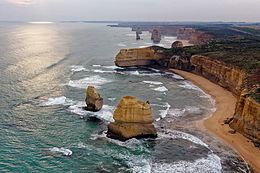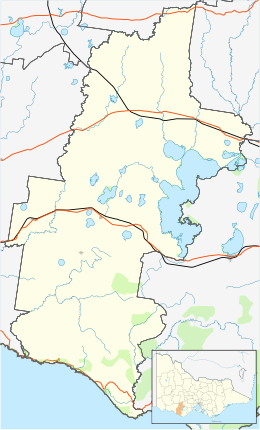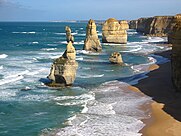geo.wikisort.org - Island
The Twelve Apostles is a collection of limestone stacks off the shore of Port Campbell National Park, by the Great Ocean Road in Victoria, Australia.
 | |
 The Twelve Apostles Location within Shire of Corangamite and, inset, Victoria | |
| Geography | |
|---|---|
| Location | Near Port Campbell, Victoria |
| Coordinates | 38°39′57″S 143°06′16″E |
| Administration | |
Australia | |
| State | Victoria |
| LGA | Shire of Corangamite |
Their proximity to one another has made the site a popular tourist attraction. Seven of the original eight stacks remain standing at the Twelve Apostles viewpoint, after one collapsed in July 2005.[1] Though the view from the promontory by the Twelve Apostles never included twelve stacks, additional stacks—not considered part of the Apostles group—are located to the west within the national park.[2]
Formation and history
The limestone unit that forms The Twelve Apostles is referred to as the Port Campbell Limestone, which was deposited in the Mid-Late Miocene, around 15 to 5 million years ago.[3]
The Twelve Apostles were formed by erosion. The harsh and extreme weather conditions from the Southern Ocean gradually erode the soft limestone to form caves in the cliffs, which then become arches that eventually collapse, leaving rock stacks up to 50 m (160 ft) high. The stacks are susceptible to further erosion from waves. In July 2005, a 50-metre-tall (160 ft) stack collapsed, leaving seven standing at the Twelve Apostles viewpoint.[1] Due to wave action eroding the cliffs, existing headlands are expected to become new limestone stacks in the future.[4]
The stacks were originally known as the Pinnacles, and the Sow and Pigs (or Sow and Piglets, with Muttonbird Island being the Sow and the smaller rock stacks being the Piglets), as well as the Twelve Apostles.[1][5] The formation's name was made official as the Twelve Apostles, despite only ever having had eight stacks.[1]
In 2002, the Port Campbell Professional Fishermens Association attempted to block the creation of the Twelve Apostles Marine National Park at the Twelve Apostles site.[6] The association approved of a later decision by the Victorian government to prohibit seismic exploration at the site by Benaris Energy,[7] believing such exploration would harm marine life.[8]
See also
- Gibson Steps
- London Arch (formerly London Bridge)
- Loch Ard Gorge
References
- "Twelve Apostles". parkweb.vic.gov.au. Parks Victoria Information Centre. Archived from the original on 22 August 2014. Retrieved 10 March 2019.
- Thomas Hunter (September 28, 2009). "Sister, not apostle, crumbles into sea". theage.com.au. Fairfax Digital. Retrieved April 24, 2019.
- Tassone, David R.; Holford, Simon P.; Hillis, Richard R.; Tuitt, Adrian K. (2012). "Quantifying Neogene plate-boundary controlled uplift and deformation of the southern Australian margin". Geological Society, London, Special Publications. 367 (1): 91–110. doi:10.1144/SP367.7. ISSN 0305-8719.
- Porter, Geoff (2006). Little Bites of Australia. Pegasus Elliot Mackenzie Pu. p. 203.
- Biunv (1 January 1898). "A picturesque resort". The Leader. p. 36. Archived from the original on 8 November 2016. Retrieved 8 November 2016.
- "Port Campbell bid to block marine national park". abc.net.au. Australian Broadcasting Corporation. 15 April 2002. Archived from the original on 18 May 2015. Retrieved 17 June 2010.
- "Fishermen welcome decision against national park seismic exploration". abc.net.au. Australian Broadcasting Corporation. 17 October 2003. Archived from the original on 29 June 2011. Retrieved 17 June 2010.
- "Otway Basin seismic survey work set to start". abc.net.au. Australian Broadcasting Corporation. 21 October 2003. Archived from the original on 29 June 2011. Retrieved 17 June 2010.
External links
На других языках
[de] Twelve Apostles (Australien)
Die Twelve Apostles (deutsch Zwölf Apostel) sind bis zu 60 Meter hohe, im Meer stehende Felsen aus Kalkstein. Sie liegen zwischen Princetown und Port Campbell im Coastal Ward des Verwaltungsbezirks Corangamite Shire im australischen Bundesstaat Victoria im Port-Campbell-Nationalpark. Sie sollen nach Uluṟu (Ayers Rock) die meistfotografierte Touristenattraktion Australiens sein. Sonnenauf- und -untergang lassen die Felsen in der Brandung leuchten. Sie bilden einen der Höhepunkte an der Great Ocean Road, einer spektakulären Küstenstraße im Südosten Australiens, und des parallel verlaufenden Pfad Great Ocean Walk.- [en] The Twelve Apostles (Victoria)
[es] Los Doce Apóstoles (Victoria)
The Twelve Apostles (en español, «Los Doce Apóstoles») es el nombre con el que se designa un agrupamiento de agujas de piedra caliza que sobresalen del mar en la costa del Parque nacional Port Campbell. Se formaron por la erosión de las rocas y movimiento. A lo largo de la ruta «Great Ocean Road» en Victoria, Australia. La proximidad de unas a otras es la causa de la curiosidad del paraje y lo que lo ha hecho una importante y popular atracción turística. Originalmente el sitio era llamado Sow and Piglets [La cerda y Los Cerdos]. La isla Muttonbird, cerca de Loch Ard Gorge era la «cerda» y las agujas de roca más pequeñas los «lechones».[1] El nombre fue cambiado en la década de 1950 por el actual, más majestuosos, que recuerda Los Doce Apóstoles bíblicos. Fue hecho para atraer a más visitantes al estado.[fr] Les 12 Apôtres
Les Douze Apôtres (« The twelve Apostles » en anglais) désigne un regroupement d'aiguilles de calcaire dépassant de l'eau en bord de mer dans le parc national de Port Campbell, le long de la route Great Ocean Road en Victoria, Australie.[ru] Двенадцать Апостолов (Австралия)
Двенадцать Апостолов[1] (англ. The Twelve Apostles) — группа известняковых скал в океане возле побережья в национальном парке Порт-Кэмпбелл, расположенных на так называемой Великой океанской дороге в австралийском штате Виктория. Их внешний вид и небольшое расстояние один от другого сделали это место популярной туристической достопримечательностью. Высота некоторых скал около 45 метров. Поначалу место носило название Соу-энд-Пиглетс («Свинья и поросята»), которое в XX веке[2] было изменено на Те-Туэлв-Апослс («Двенадцать Апостолов»)[3], при том что в группе было только 9 скал. Соу («свинья») был остров, а Пиглетс («поросята») — отделившиеся скалы. В настоящее время скал осталось 8, так как одна из них в 2005 году обрушилась, не выдержав воздействия эрозии[4].Другой контент может иметь иную лицензию. Перед использованием материалов сайта WikiSort.org внимательно изучите правила лицензирования конкретных элементов наполнения сайта.
WikiSort.org - проект по пересортировке и дополнению контента Википедии

